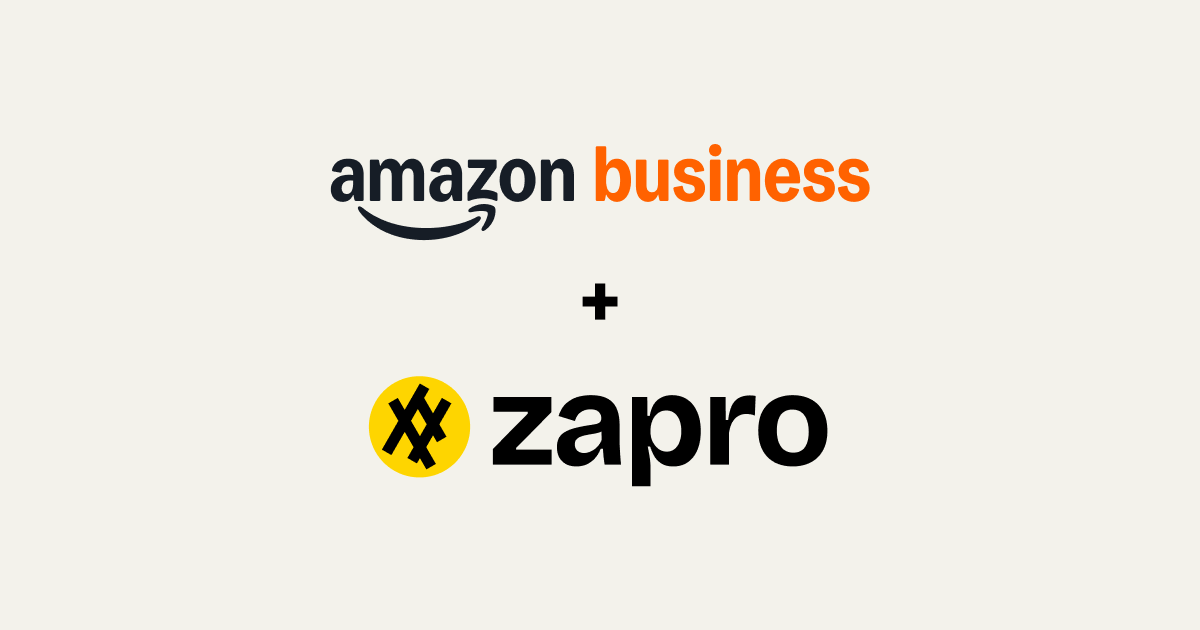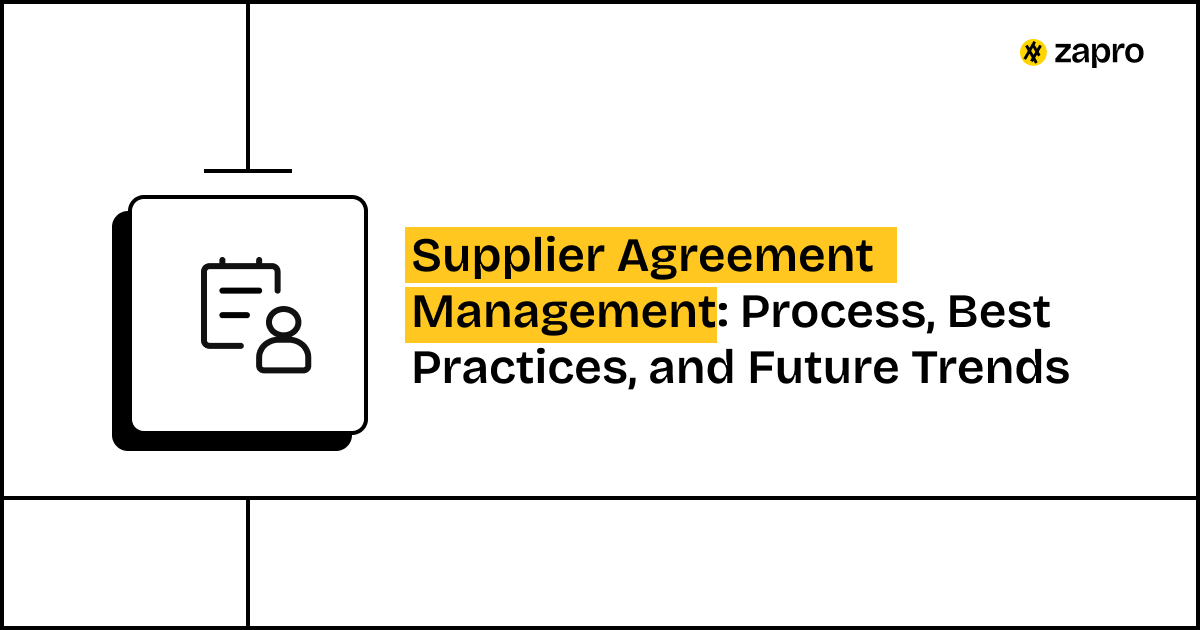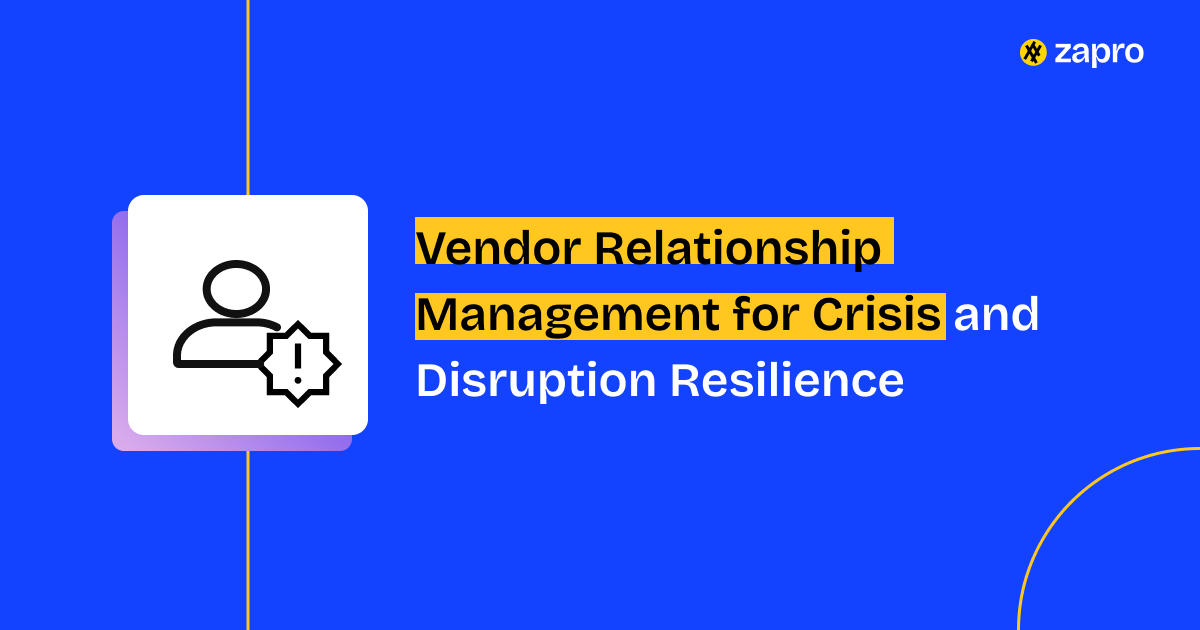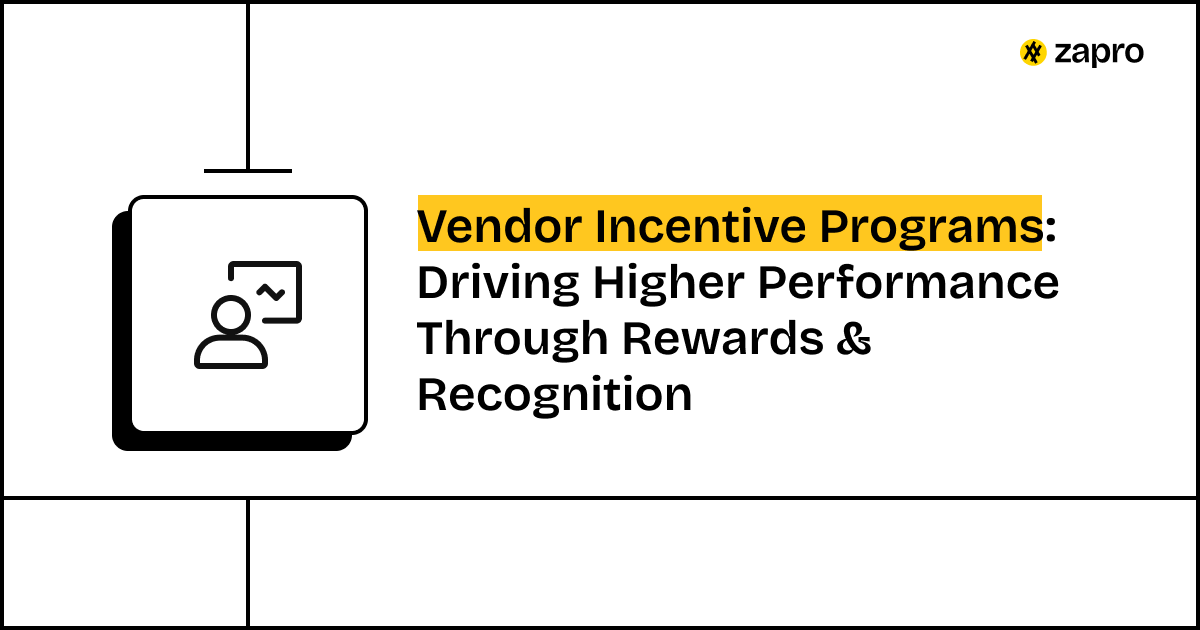What is supplier agreement management (SAM)
Supplier Agreement Management (SAM) describes the complete cycle of creating supplier agreements through negotiation and implementation and ongoing maintenance of these agreements between businesses and their suppliers. The agreements contain essential information about pricing and quality requirements and delivery schedules and performance targets and risk distribution terms.
Purpose of supplier agreement management
The fundamental purpose of SAM connects supplier operations to business targets while making sure commitments produce quantifiable results. Procurement teams in modern times use Vendor Management Systems and Supplier Management Software and Supplier Relationship Management Software to automate documentation processes and streamline approval workflows and track all supplier contracts from a centralized platform.
Why SAM matters for procurement and business success
- The organization gains risk protection through specific contractual terms which defend it from legal and operational risks.
- The implementation of structured agreements with performance-based KPIs enables organizations to achieve better cost management and performance tracking.
- The process of monitoring suppliers under consistent rules helps businesses maintain both regulatory compliance and company policy adherence.
- The use of transparent agreements creates conditions for better trust between partners which leads to successful Supplier Relationship Management.
- The implementation of Vendor Management Tools with digital workflows enables organizations to achieve operational efficiency by automating manual work and accelerating the renewal and compliance assessment processes.

By 2027, 50% of organizations will support supplier contract negotiations through the use of Artificial Intelligence (AI)-enabled contract risk analysis and editing tools
– Kaitlynn Sommers, Senior Director Analyst, Gartner Supply Chain Practice
Supplier agreement vs. contract management: What are the key similarities and differences?
The terms “supplier agreement management” and “contract management” share common usage but they represent distinct concepts. The two concepts share common ground in legal commitments and compliance but they operate under different parameters.
Supplier agreement
A supplier agreement functions as a particular contract which outlines all essential details about supplier expectations and performance requirements for business relationships.
Contract management
The process of contract management encompasses all types of agreements which include customer and employee contracts as well as leases and partnerships and supplier agreements.
Common characteristics
- The two systems of supplier agreement management and contract management present multiple common characteristics.
- The systems guarantee organizations follow both legal requirements and operational standards.
- The documents contain all necessary details about terms and conditions and performance requirements.
- The documentation process together with transparency systems within these systems help organizations avoid disputes.
Strategic differences
The management of supplier agreements and contracts operates with different strategic goals and employs distinct tools for their administration.
Comparison table
| Aspect | Supplier Agreement Management | Contract Management |
| Focus | The system focuses on supplier relations and procurement rules and performance requirements. | The system handles all business agreements which include sales contracts as well as human resources agreements and partnership agreements. |
| Objectives | The system works to guarantee suppliers meet their obligations for quality standards and cost-effectiveness and regulatory compliance. | The system protects organizational risk through its management of all different contract types. |
| Stakeholders | The teams responsible for procurement finance operations and legal departments make up the stakeholders. | The teams responsible for legal matters and compliance and finance and business development work together. |
| Metrics | The performance metrics include delivery times and supplier performance and contract adherence rates. | The system tracks contract lifecycle performance and monitors renewal success rates and identifies potential risks. |
| Tools | The tools for managing suppliers include Vendor Management Systems and Supplier Management Software and Supplier Relationship Management Software. | Organizations use Contract Lifecycle Management (CLM) platforms together with document repositories to manage their contracts. |
When to use each approach
Supplier agreement management
The supplier agreement management system works best for organizations that want to improve procurement performance and maintain supplier accountability while achieving relationship success. The system works best for organizations that handle various suppliers and complicated sourcing categories.
Contract management
The system enables organizations to handle all legal agreements through enterprise-wide governance starting from supplier contracts up to corporate partnerships.
Combined approach
Most organizations require both approaches for their operations. The process of creating and monitoring and optimizing supplier agreements takes place under the umbrella of a complete contract management system.
Companies achieve their best results through procurement and legal team collaboration which uses integrated Vendor Management Tools or Supplier Relationship Management platforms to connect agreements with supplier performance data.
Transform supplier agreement chaos into automated control.

The supplier agreement management process
Supplier Agreement Management (SAM) requires more than creating contracts because it involves a complete system for selecting suppliers and establishing performance standards and tracking their progress.
The structured process of supplier agreement management includes five main stages.
Step 1: Conduct a needs assessment
Organizations need to determine their exact requirements which include materials and services and delivery times and performance standards. The process of supplier agreement development must support both strategic and operational objectives of the organization.
Quick checklist for this phase:
- Define specifications and scope.
- The process requires stakeholders to confirm their budget expectations and project requirements.
- The process requires suppliers to meet specific compliance and sustainability requirements.
- The use of Supplier Management Software and Vendor Management Tools during this phase enables organizations to manage requirements and obtain approval through a centralized system.
Step 2: Identify and select suppliers
The selection process for suppliers begins after needs assessment through evaluation of their capabilities and reliability and their past compliance history. The evaluation process includes RFPs and scorecards to determine pricing and quality standards and supplier suitability.
The evaluation and onboarding process for suppliers becomes more efficient through modern Vendor Management Systems which operate as automated systems.
Step 3: Draft and negotiate supplier agreements
The partnership foundation emerges through this step which establishes roles and pricing structures and performance measurement criteria and penalty systems. Every agreement clause should contain clear and equitable terms.
The collaborative Supplier Relationship Management Software enables teams to create and review and edit agreements through an efficient process.
Step 4: Execute and monitor agreements
The execution and monitoring phase begins after suppliers sign their agreements through digital or manual methods. The system tracks supplier performance through KPIs that measure delivery times and costs and product quality standards.
The integration of Vendor Management Systems provides real-time access to data and automatic alerts for both compliance and renewal processes.
Step 5: Review, modify, and renew agreements
Business environment changes require organizations to conduct periodic agreement assessments for maintaining agreement validity. The evaluation process assesses supplier performance to determine needed adjustments for terms and pricing.
Supplier Relationship Management tools enable teams to track supplier performance which helps them decide between contract renewal or renegotiation or supplier termination.
Key components of a supplier agreement
A supplier agreement with proper structure protects both parties through clear terms that create transparency and accountability and deliver lasting value. The quality of your supplier partnership definitely depends on how well you actually define essential agreement elements.
1. Roles, responsibilities, and deliverables
Every agreement needs to establish precise roles and responsibilities and responsibilities and deliverables for all parties involved.
The agreement must outline all responsibilities of each party including delivery times and quality requirements and reporting requirements.
The defined roles help prevent confusion while creating specific performance targets that can be measured.
The tracking of deliverables and real-time responsibility assignment and compliance monitoring becomes possible through Supplier Management Software and Vendor Management Systems.
2. Pricing, payment terms, and performance metrics
Any supplier agreement requires pricing structures and payment terms to function as its core elements. The established payment terms help suppliers maintain financial stability and maintain their responsibility to the business.
The essential elements of this section must include:
- Payment schedules and methods
- Discounts, penalties, or incentives
- The agreement should ideally include performance-based KPIs that measure delivery accuracy and also cost efficiency as well as service levels.
The integration of these terms into Vendor Management Tools enables automatic performance tracking and Vendor Management Process evaluation.
3. Compliance, risk management, and force majeure clauses
The agreement must contain specific provisions which handle compliance requirements and regulatory standards and unexpected interruptions. The specified provisions safeguard both parties from experiencing financial damage and operational disruptions.
Typical inclusions:
- Data security and confidentiality terms
- The agreement must include requirements for ethical sourcing and anti-bribery practices.
- The agreement includes force majeure provisions which protect against natural disasters and political instability and other uncontrollable events.
Supplier Relationship Management Software provides automated compliance alerts which help organizations maintain audit readiness and risk awareness.
4. Termination and renegotiation terms
Every agreement needs to establish specific conditions for ending the contract and renewal procedures. The use of specific exit provisions in agreements helps prevent disputes by providing clear termination and renewal procedures.
Best practices include:
- The agreement should include specific timeframes for termination and renewal notifications.
- The agreement enables performance-based renegotiations and market condition-based renegotiations.
- The Vendor Management Systems should track all modifications to ensure complete transparency.
The defined closure and renewal terms in agreements maintain business flexibility while keeping relationships active during times of change.
Best practices for supplier agreement management
The development of powerful supplier agreements depends on ongoing management practices together with open communication and team collaboration. Five proven methods exist to enhance the effectiveness of supplier agreement management.
1. Centralize contracts and compliance records
All supplier contracts and their related documentation and compliance records need to be stored within a single digital database.
A centralized system for storing all supplier contracts and their addendums and compliance records should exist.
A Vendor Management System or Supplier Management Software enables better visibility while minimizing version errors and streamlining audit processes.
2. Establish performance metrics and review cadence
The process requires organizations to establish specific KPIs for delivery accuracy and cost savings and compliance rates which need regular assessment.
Your Vendor Management Tools should include tracking features to support performance discussions through actual data evidence.
3. Build trust through communication and fair negotiation
The development of trust relationships between organizations and their suppliers requires active communication and fair negotiation practices.
The process requires more than following rules and regulations.
Organizations that maintain open dialogue and conduct fair business negotiations will develop stronger partnerships which demonstrate greater strength and resistance to change.
4. Integrate digital tools for operational efficiency
Digital tools should be integrated to enhance operational efficiency.
The use of AI-powered Supplier Relationship Management Software enables organizations to automate their routine operations including renewal processes and approval and reminder functions.
The system decreases human work while maintaining continuous Vendor Management Process updates.
5. Align agreements with business strategy
All supplier agreements need to match the strategic objectives of the business organization.
The alignment of contracts with business objectives enables procurement teams to show strategic value beyond their operational support role.
Common challenges in supplier agreement management
The implementation of clear processes does not prevent supplier agreements from facing problems which affect their cost performance and compliance levels. Early detection of these challenges enables teams to prevent their occurrence.
1. Vague or ambiguous terms
The lack of clear language in agreements creates misunderstandings that result in delivery problems and disputes between parties.
Standardized templates stored in Vendor Management Systems enable procurement and legal teams to achieve consistency which reduces overall risk exposure.
2. Cross-border regulatory and cultural differences
The process of global sourcing creates multiple challenges because it involves different legal frameworks and business practices and language systems.
The Vendor Management Software enables users to monitor international supplier compliance requirements and regional regulatory needs.
3. Scope expansion and value loss
The process of controlling scope expansion while stopping value loss.
The lack of proper documentation for expanded deliverables results in higher costs and reduced performance levels.
Vendor Management Tools enable teams to monitor changes through regular reviews which ensure proper documentation and contract compliance.
4. Tracking savings vs. achieving savings
The process of tracking savings does not equal the actual achievement of savings.
The procurement department can identify savings through negotiation but faces difficulties in achieving these savings when executing contracts.
The Vendor Management Process enables teams to monitor actual spend through agreement integration which helps them achieve their savings targets.
Technology in supplier agreement management
The implementation of technology has evolved supplier agreement management from its traditional paper-based system into an integrated data-based system. Digital solutions enable procurement teams to monitor their operations better while decreasing risks and achieving higher efficiency from start to finish of agreement management.
1. Role of contract management systems (CLM)
The Contract Lifecycle Management (CLM) system enables automated processes for agreement development and approval and renewal management.
The combination of Vendor Management Systems and Supplier Management Software with CLMs enables data consolidation and milestone tracking and ensures all contractual clauses remain compliant and accessible.
2. Electronic signatures and digital documentation
Businesses can use e-signature solutions to complete agreements quickly while upholding complete legal protection.
Vendor Management Tools store digital documents which replace paper-based systems to provide quick approval processes and easy access for audit reviews and contract renewal procedures.
3. AI and automation for compliance monitoring
AI-based analytics systems identify potential non-compliance threats and identify irregularities and recommend preventive measures before problems become major issues.
The automated system maintains real-time updates for renewal alerts and KPI notifications and supplier performance assessments which minimizes human work and enhances Vendor Management Process precision.
4. Integration with procurement and ERP systems
The system enables automatic connection between supplier agreements and purchase orders and invoices and performance records.
The integration of CLM tools with Supplier Relationship Management Software or ERP systems provides complete visibility throughout the entire process from contract development to payment processing which enables faster and smarter business decisions.
Post-signature value creation
The actual worth of supplier agreements emerges after the signing process concludes. The process of post-signature management makes sure all contractual obligations produce quantifiable business results.
1. The implementation of agreements within procurement workflows
The integration of supplier agreements into regular procurement activities helps organizations verify that suppliers maintain their agreed-upon terms and service level agreements.
A Vendor Management System or Supplier Management Software enables better traceability and compliance by linking agreements to purchase orders and invoices and approval processes.
2. Ongoing supplier performance management
The evaluation of supplier performance includes their ability to meet their commitments regarding quality standards and delivery times and cost management.
The combination of Vendor Management Tools with performance dashboards through contracts enables better accountability and ongoing improvement within Vendor Management Process operations.
3. Governance programs for continuous improvement
The process requires organizations to conduct scheduled review meetings and perform audits and performance evaluations.
Supplier Relationship Management Software enables organizations to maintain consistent reporting and risk tracking and business goal alignment through their governance frameworks.
Future of supplier agreement management
The practice of supplier agreement management has evolved from being a compliance-based function into a strategic business value generator. The evolution of global supply chains through technological advancements and sustainability initiatives requires procurement leaders to develop strategies for connected intelligent and responsible supply chain operations.
1. Digital transformation patterns
The upcoming evolution of SAM will concentrate on automated systems which link data points to generate predictive business intelligence.
Cloud-based Vendor Management Systems and Supplier Management Software will link with AI-driven analytics to monitor supplier performance and risks and opportunities throughout the Vendor Management Process in real-time.
2. AI-driven contract analytics
The analysis of contracts through AI technology will become essential for risk detection and dispute prediction in advance of their occurrence.
The extraction of valuable insights from large numbers of supplier agreements through advanced tools enables teams to make expedited strategic decisions and enhance their negotiation approaches.
3. Sustainable and ethical sourcing practices with ethical considerations
Organizations now include sustainability standards and diversity requirements and ethical sourcing protocols within their supplier agreement frameworks.
The transition promotes both openness and responsibility between suppliers and their customers because it requires them to follow worldwide ESG standards which form a fundamental element of contemporary Vendor Management Best Practices.
4. Training teams for next-gen contract management
The success of technology implementation depends on human professionals who need to develop their skills as well.
The complete utilization of modern Supplier Relationship Management Software requires procurement and legal teams to receive ongoing education about digital tools and analytics and risk management practices.
Companies which treat supplier agreements as active frameworks for innovation and compliance and shared development will lead the future market.
Why Zapro is the smarter choice for supplier agreement management
Business performance depends on supplier agreement management which has evolved from a legal requirement into a strategic business enabler. The entire process requires precise management of supplier roles and compliance monitoring and KPI tracking and collaborative efforts between teams.
The current global supply chain operations exceed the management capabilities of traditional spreadsheets and unorganized workflows. Zapro stands out as a solution.
The Zapro platform unites Vendor Management with Supplier Relationship Management and Contract Automation capabilities to deliver complete control for procurement and finance teams.
With Zapro you can:
- Enable complete transparency through centralized and digitized supplier agreements.
- The system should automate the process of contract renewal management and performance tracking and compliance alert production.
- Access supplier performance data and spending optimization metrics instantly.
- The system enables procurement teams to link with finance and legal departments for better collaboration.
- Build stronger supplier relationships through agreement management systems that drive long-term business expansion.
Zapro serves as an advanced solution for organizations that seek to move beyond traditional manual systems and separate platforms by implementing intelligent supplier agreement management solutions.
Ready to simplify and strengthen your supplier agreement management?
Book a free demo with Zapro today and experience how smarter automation can transform your supplier relationships.

Stop manual contract tracking. Automate with Zapro.
Stop managing supplier agreements in spreadsheets. Zapro automates contracts, renewals, and compliance.
FAQs on supplier agreement management
1. What is the difference between a supplier agreement and a vendor agreement?
A supplier agreement is a bit different in that it can establish business terms for ongoing delivery of goods and services with a definite focus on performance quality. But the vendor agreement focuses on single transactions and brief supply contracts.
2. How often should I review and update my supplier agreements?
Businesses should review their supplier agreements yearly but must conduct an immediate review whenever pricing modifications happen or new regulatory requirements appear or supplier performance weakens. The process of reviewing agreements on a regular basis helps organizations maintain agreements which match their business objectives.
3. What happens if a supplier breaches the agreement?
The agreement contains a breach clause which specifies the necessary steps for handling non-compliance through corrective measures and penalty enforcement and termination options. A Vendor Management System enables better early detection of issues because it tracks supplier compliance.
4. Can small businesses draft supplier agreements without expensive legal fees?
Yes. Small businesses can generate legally compliant agreements through the use of templates and digital contracting solutions and Supplier Management Software. A legal professional should review all essential contracts even though it is possible to draft supplier agreements without their help.
5. How can AI improve supplier agreement management?
AI systems perform real-time analysis of contracts to detect potential risks and track compliance status. The current generation of Vendor Management Tools uses AI technology to automate renewal operations and identify abnormal activities while producing valuable data for better supplier oversight.
6. Can I have multiple supplier agreements with the same supplier?
Absolutely. Businesses can establish multiple agreements for different product lines and geographic areas and service domains provided they maintain distinct boundaries between each agreement. The agreements must establish their own specific terms which prevent any overlapping conditions.
7. What are the most important clauses in a supplier agreement?
A supplier agreement requires four fundamental elements which consist of pricing information and performance requirements and confidentiality terms and dispute handling mechanisms and termination protocols. The specified clauses establish responsibility and safeguard both parties during their supplier partnership.
Don’t miss our weekly updates
We’ll email you 1-3 times per week—and never share your information.
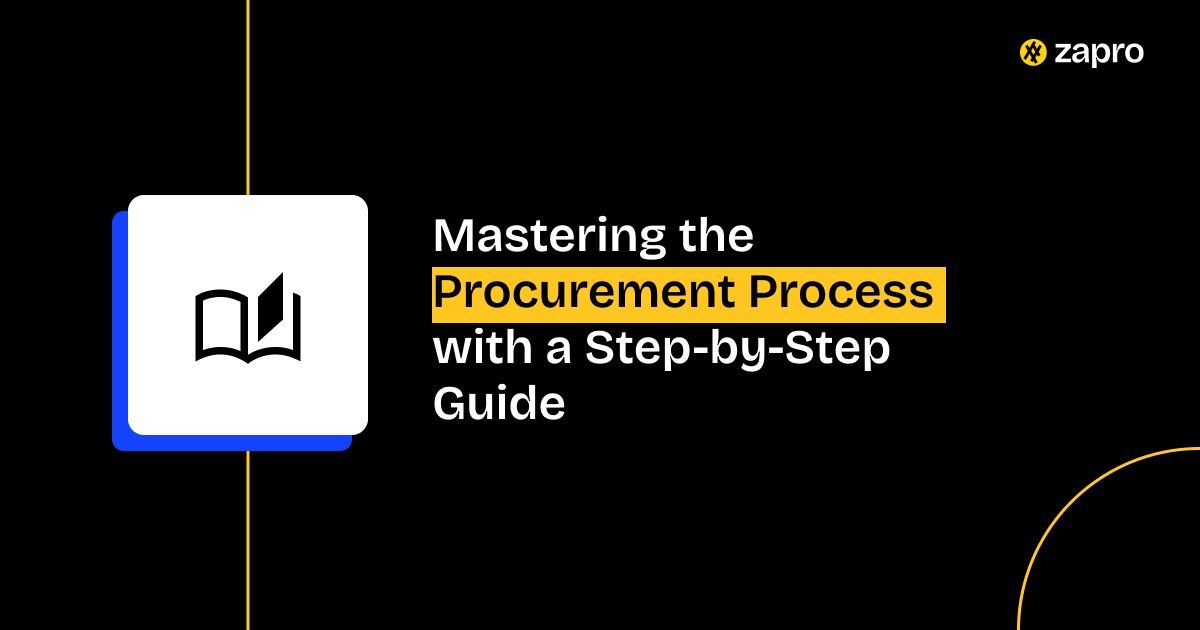
 Healthcare
Healthcare Financial Services
Financial Services Technology
Technology Venture Capitalist
Venture Capitalist Chief Procurement Officer
Chief Procurement Officer Chief Financial Officer
Chief Financial Officer